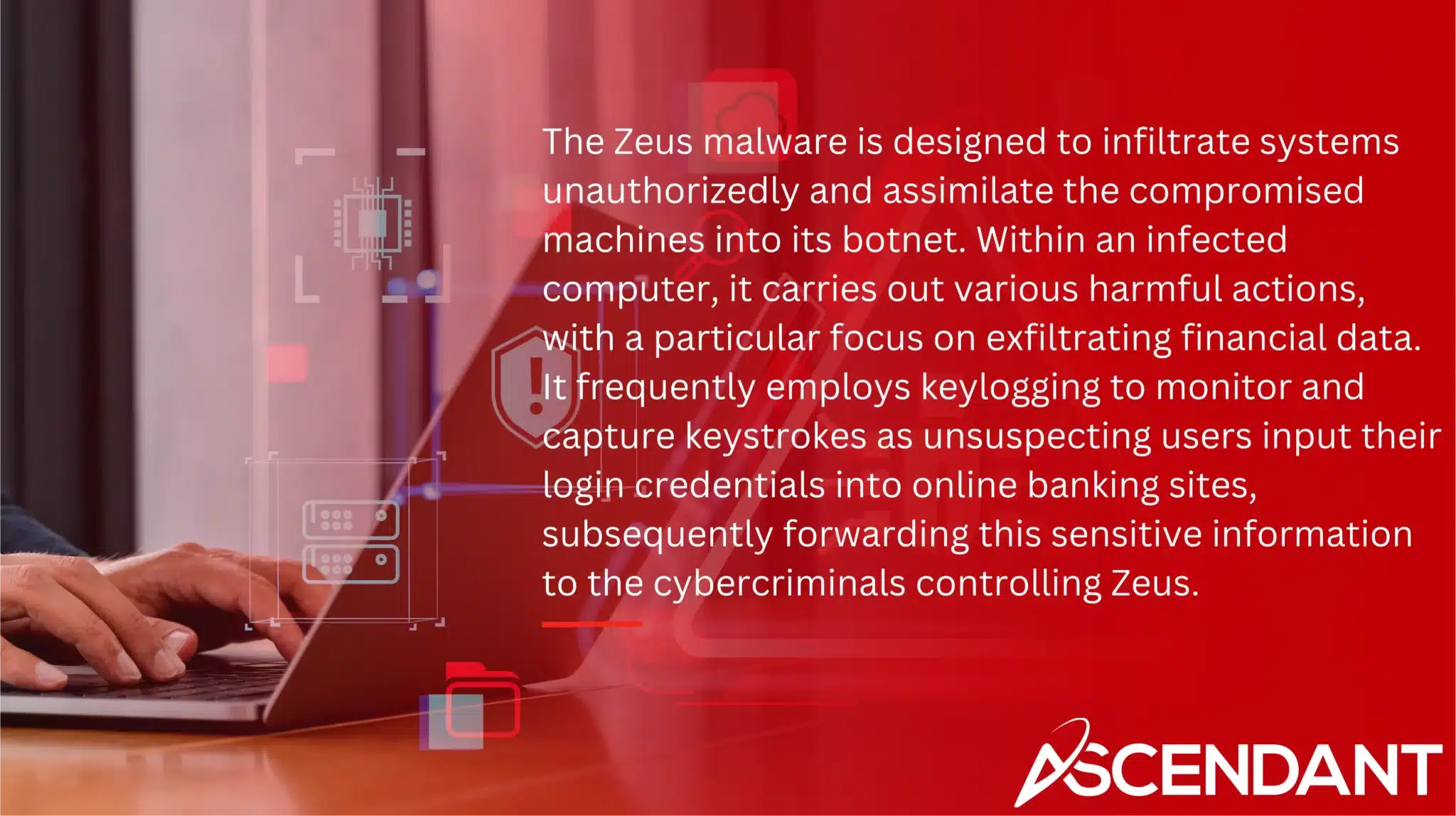The Zeus Virus, notorious for stealing banking information, has been a significant cybersecurity threat since 2007. This malware adapts to evade detection, causing financial losses and data breaches. In this article, learn what the Zeus Virus is, how it spreads, and steps to protect against it.
Key Takeaways
- The Zeus Virus, or Zbot, is a sophisticated banking Trojan designed to steal sensitive financial information, evolving since its creation in 2007.
- Common infection methods for Zeus include phishing attacks and drive-by downloads, exploiting outdated software and web browsers to gain unauthorized access.
- Effective prevention of Zeus infections relies on user awareness, up-to-date antivirus software, and safe internet practices, including avoiding suspicious emails and websites.
What is the Zeus Virus?
Known alternatively as Zbot, the Zeus Trojan is a piece of malicious software that has garnered infamy within the realm of cybersecurity. Originating in 2007, its main function lies in illicitly capturing sensitive banking particulars like login credentials and financial information, hence its recognition as an egregious banking trojan. With time, it has demonstrated remarkable adaptability to counteract advancements in security protocols while employing increasingly complex propagation techniques.
The danger posed by Zeus stems from its inherent versatility. In an alarming development back in 2011, cybercriminals gained access to a treasure trove when the source code for the virus became openly available on various platforms. This event enabled nefarious actors worldwide to modify and tailor this already potent malware for their specific agendas—a move that substantially hindered efforts towards detection and eradication due to customizability enhancing the ability of Zeus variants to target disparate systems with new-found precision.
Regardless if it’s identified as ZeuS or Zbot—among other monikers—the destructive capacity of this trojan continues unabated. Such nomenclature serves only to underscore its insidious presence across cyberspace. Grasping both how it originated and how it evolved over time remains paramount for those invested in spotting signs indicative of infection early on so they may fortify defenses accordingly against this ongoing digital menace seeking out confidential financial data.
How Zeus Virus Operates

The Zeus malware is designed to infiltrate systems unauthorizedly and assimilate the compromised machines into its botnet. Within an infected computer, it carries out various harmful actions, with a particular focus on exfiltrating financial data. It frequently employs keylogging to monitor and capture keystrokes as unsuspecting users input their login credentials into online banking sites, subsequently forwarding this sensitive information to the cybercriminals controlling Zeus.
Beyond keylogging, Zeus utilizes form-grabbing methods for seizing passwords and additional critical data directly from web forms. This tactic proves especially damaging for online banking accounts and e-commerce platforms where personal details are often submitted. The power of the entire Zeus botnet can also be harnessed to execute distributed denial-of-service (DDoS) attacks that aim to incapacitate targeted services by flooding them with traffic.
A notable characteristic of the Zeus malware is its capacity for evading detection within host devices. Through deceptive means such as drive-by downloads or phishing attacks which lure individuals into activating malevolent links or attachments—the malware gains entry undetected. Upon installation, it deploys sophisticated techniques to elude traditional antivirus software defenses until activated for malicious operations. Thereby demonstrating considerable resilience in maintaining presence without discovery—posing an ongoing risk of enduring malware infections.
Methods of Infection
Zeus malware often proliferates through phishing attacks, with cybercriminals sending deceptive emails that mimic reputable sources. These emails bait individuals into interacting with malevolent links or downloading tainted attachments, resulting in the user inadvertently deploying the Zeus malware on their device.
Malicious advertisements presented online also serve as a conduit for Zeus distribution. Even high-trust websites can unknowingly host such ads which may initiate unsolicited downloads of this pernicious code upon engagement by an unsuspecting user – an attack mode known colloquially as “drive-by downloads.” The mere act of landing on an infected site might trigger automatic download and installation procedures for the Zeus malware without any active participation from users.
The susceptibility to these drive-by installations is exacerbated when attackers target web browsers and software that are not up-to-date. Legacy versions of browsers frequently lack robust security measures to block unwanted automated downloads effectively, leaving systems more exposed to malign invasions like those instigated by the Zeus trojan horse. Users who diligently update their browsers and other programs significantly enhance their defenses against potential encounters with this harmful software.
Consequences of Zeus Malware Attack
The repercussions of a Zeus malware infection are profound, with considerable financial ramifications for those affected. Notably adept at pilfering banking credentials and confidential data, the damage inflicted by this malicious software has been estimated by the FBI to exceed $100 million in losses. Individuals afflicted by a Zeus attack frequently discover their bank accounts emptied, an ordeal that often leads to intense economic distress and an arduous journey towards monetary restitution.
Aside from its primary function of extracting financial information, the potency of Zeus malware lies in its ability to grant perpetrators total dominion over compromised systems. Such access paves the way for additional breaches involving private identification particulars and sensitive business records. In certain episodes, attackers have leveraged the Zeus Trojan as a conduit for deploying Ransomware threats on infected devices—exacerbating already grave circumstances.
Exemplifying its capacity for broad-scale disruption, high-profile entities like the U.S Department of Transportation have fallen prey to sophisticated endeavors orchestrated using Zeus trojans. Its deployment not only facilitates direct assaults, but also serves in distributed denial-of-service (DDoS) strategies – underlining a significant risk factor associated with this type of cyber intrusion. Consequently, both individuals and expansive institutions bear serious implications stemming from infections linked to this formidable piece of malware.
Detecting Zeus Malware
The task of identifying the presence of Zeus malware can be particularly strenuous as a result of its sophisticated evasion techniques. Antivirus programs often struggle to detect this type of malware, especially the fileless strains which cleverly utilize a system’s native processes without leaving significant evidence on the hard drive.
Zeus botnets are notorious for their ability to operate covertly over extended durations, with infected hosts potentially remaining inactive until they receive commands to carry out harmful actions. This strategic latency in activation is designed specifically to circumvent traditional security defenses and persist undetected within networks.
Zeus reinforces its stealth by utilizing encrypted communication channels between compromised devices and the command and control server. The obfuscation provided by encryption significantly hampers attempts by security software systems to intercept and analyze communications from these bots. Consequently, thwarting Zeus requires not just an antivirus that is regularly updated, but also proactive surveillance for any anomalous behavior indicative of such infections.
Preventing Zeus Infections
To safeguard against Zeus malware infections, it’s essential to blend technical safeguards with user vigilance. Users must become adept at identifying credible contacts and spotting dubious emails to thwart phishing attempts associated with Zeus. Abstaining from engaging with links or attachments in messages from unfamiliar sources is a critical practice.
Securing robust antivirus software that provides regular updates to counteract new malware strains is another key strategy for defending against Zeus attacks. It’s crucial to maintain current antivirus defenses as they can halt the download of compromised files and restrict entry to malicious websites. Businesses should Bolster their security by adopting two-factor authentication alongside endpoint protection strategies.
Adhering to prudent online habits significantly contributes to staving off incidents involving Zeus malware. It’s advised that individuals refrain from navigating uncertain or potentially hazardous web domains, including those hosting adult content or purporting illegal free downloads of software applications. Sticking exclusively to legitimate channels for acquiring licensed programs greatly reduces Trojan threats exposure risks. Employing password managers offers secure means of storing login credentials, while activating two-factor authentication on banking sites delivers an additional shield protecting users from unwelcome intrusions courtesy of the troublesome Zeus virus.
Removing Zeus Trojan Malware
Employing a methodical strategy is crucial for eradicating Zeus Trojan malware. Initiate by deploying a dedicated trojan removal tool tailored to target and expunge the Zeus malware. To minimize interference from the malicious software during this operation, initiate your computer in Safe Mode after installing suitable antivirus software.
While operating in Safe Mode, execute an exhaustive system scan with the installed antivirus program to pinpoint all traces of malevolent programs, including any instances of the Zeus Trojan. Adhere strictly to the instructions that accompany any detected infections within your system for thorough eradication. Post-cleanup, it’s prudent to modify all personal passwords and vigilantly observe account activities for anomalies ensuing from potential security breaches.
To bolster defenses against such invasive threats as Trojan malware, consistently updating antivirus solutions is essential along with habitual scans of one’s computing environment. Maintaining these proactive measures affords users robust protection against not only existing but also future incursions by viruses akin to the insidious Zeus Trojan malware.
The Legacy of Zeus Malware
The enduring influence of Zeus malware in the cyber threat environment can be attributed to its ability to evolve and persist over time. GameOver Zeus, one of its most harmful derivatives, has been notorious for enabling ransomware strikes that encrypt victims’ files and force them into paying a ransom for their release. Within the Gameover Zeus botnet, each compromised machine connects via peer-to-peer networks secured with encryption, posing significant challenges to disrupt.
GameOver Zeus is designed specifically to target financial information by secretly injecting malicious scripts into web browsers. This allows it to directly filch confidential data from unsuspecting individuals. The associated ransomware aspect employs robust RSA-2048 encryption techniques when locking away user files, thereby intensifying the security risks posed by this variant. Access to the GameOver Zeus botnet infrastructure has been commoditized — leased out as a service — Broadening its negative implications throughout cyberspace.
Since 2011’s unauthorized disclosure of the zeus source code resulted in an array of different offspring strains bearing distinct cybersecurity threats. law enforcement agencies along with cybersecurity professionals have faced persistent challenges tackling these dangers head-on. Nevertheless, even amid ongoing countermeasures against such nefarious activities, both existing incarnations and newly emerging forms continue drawing inspiration from initial instances tied back.To original.
Zeus creations signify how critical constant alertness remains alongside continual progress within realms dealing. With protective measures online.
Summary
Grasping the workings of Zeus malware is essential to fend off its destructive impact. Acknowledging the methods through which it proliferates and grasping the ramifications of falling prey to this perilous trojan enable entities and persons alike to establish robust defenses capable of identifying, obstructing, and eliminating such threats. Maintaining awareness and alertness remains a fundamental strategy in shielding against Zeus as well as other nascent malware challenges.
 Frequently Asked Questions
Frequently Asked Questions
What is the primary purpose of the Zeus Virus?
The main objective of the Zeus Virus is to obtain confidential banking details, such as login information, in order to enable monetary deceit.
How does Zeus malware remain hidden on infected systems?
Zeus malware remains hidden on infected systems by employing advanced stealth techniques, activating only when required to execute its malicious tasks, effectively evading detection.
What are common methods of Zeus malware infection?
Zeus malware commonly infects systems through phishing attacks, malicious online advertisements, and drive-by downloads from compromised websites.
It is crucial to remain vigilant and implement security measures to protect against these threats.
How can I prevent a Zeus infection?
Employing reliable antivirus software, activating two-factor authentication, and practicing safe internet habits such as avoiding questionable websites and emails are essential measures to fend off a Zeus infection.
Adhering to these precautions can greatly minimize the threat posed.
What is the legacy of GameOver Zeus?
GameOver Zeus has established a lasting legacy as an early innovator in the realm of ransomware, particularly noted for its advanced encryption techniques used to compromise financial data.
This impact underscores the enduring significance of implementing robust cybersecurity protocols.

